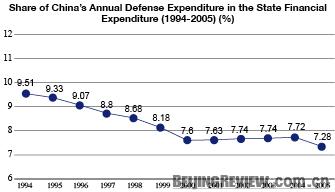|
It was the biggest arms sale to Taiwan since China. The United States signed the "August 17 Communiqué" in 1982, in which the United States agreed to gradually reduce its arms sales to Taiwan.
At the press conference, held several hours before U.S. President Barack Obama's inauguration, Hu urged the new U.S. administration to remove barriers to bilateral military relations.
Military contacts between the two countries were active and fruitful before the Taiwan arms sale. Apart from frequent exchanges at different levels, the two defense departments set up hotlines and military officials got involved in bilateral strategic talks for the first time in 2008.
Military expenditure
In the face of "unprecedented opportunities and challenges," China will "persist in taking the road of peaceful development," the paper said.
The paper for the first time reviewed China's defense expenditure for the last three decades, saying it stayed at "a reasonable and appropriate level."

Although China's defense expenditure increased from 1988 to 2008, the total amount and per-service-person share of China's defense spending remained lower than those of some major powers, the paper said.
In 2007 China's defense expenditure equaled 7.51 percent of that of the United States and 62.43 percent of that of Britain. China's defense expenses per service person amounted to 4.49 percent of that of the United States, 11.3 percent of that of Japan, 5.31 percent of that of Britain, 15.76 percent of that of France and 14.33 percent of that of Germany. As for the share of defense expenditure in GDP, China's was merely 1.38 percent, while in the United States it was 4.5 percent, in Britain 2.7 percent, and in France 1.92 percent.
From 1998 to 2007, "the average annual increase of defense expenditure was 15.9 percent, while that of GDP was 12.5 percent and that of state financial expenditure was 18.4 percent. Although the share of China's defense expenditure in its GDP increased, that in the state financial expenditure continued to drop on the whole."
The white paper said in the past two years, the increased part of China's defense expenditure has primarily been used for raising the salaries and benefits of servicemen, compensating for price rises and military informationization.
The paper also for the first time devoted separate chapters to the army, navy, air force and second artillery force, introducing their capacities and functions.
In recent years, the army has been moving from regional defense to transregional mobility. It is gradually making its units small, modular and multifunctional in organization through appropriate downsizing and structural reform.
China's submarine force is equipped with nuclear-powered strategic missile submarines, nuclear-powered attack submarines and conventional submarines, all organized into submarine bases and submarine flotillas.
China's air force is working to accelerate its transition from territorial air defense to both offensive and defensive operations, and increase its capabilities for carrying out reconnaissance and early warning, air strikes, air and missile defense, and strategic projection, in an effort to build itself into a modernized strategic air force.
Defense Figures at Home and Abroad
Since 1990, China has sent 5,915 military personnel to participate in 16 UN peacekeeping operations. Eight lost their lives and several dozen were wounded on duty.
By the end of 2005, China had reduced the People's Liberation Army (PLA) by 200,000 troops as announced in 2003. The PLA currently has 2.3 million troops.
China has participated in 11 international counterterrorism treaties. The People's Armed Police Force (PAPF) has sent delegations to over 30 countries for bilateral or multilateral counterterrorism exchanges.
Since 2002, China has held 16 joint military exercises with 11 countries and established military ties with over 150 countries.
During the massive earthquake in Sichuan Province, the PLA and PAPF deployed 146,000 troops and mobilized 75,000 militiamen and reservists.
PAPF also contributed 85,000 troops to Olympic security work, appropriately handled nearly 300 incidents which might have endangered guarded targets, and confiscated over 9,000 prohibited items.
Source: China's National Defense in 2008
| 